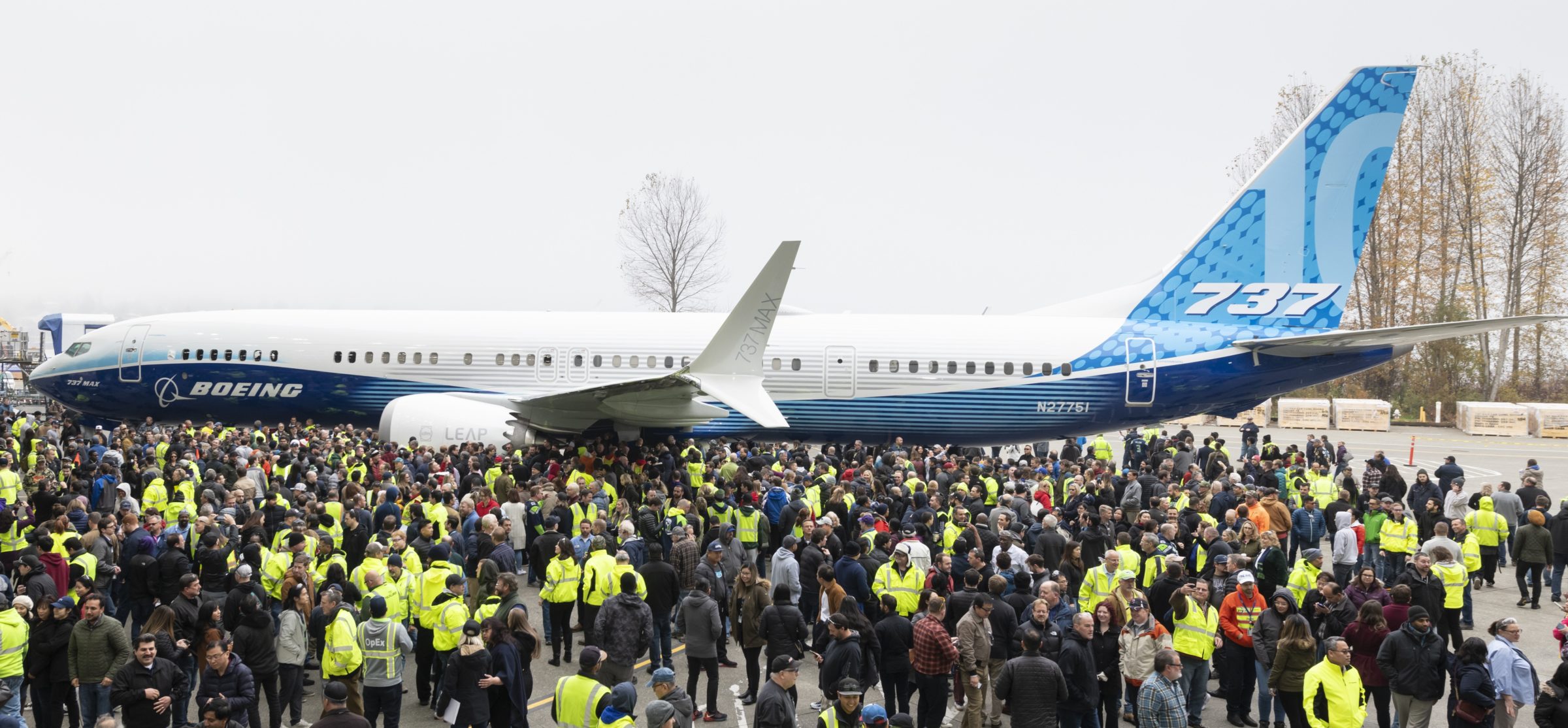Leeham News and Analysis
There's more to real news than a news release.
 Leeham News and Analysis
Leeham News and Analysis
- The Boeing 767 Cross Section, Part 1 November 24, 2022
- Movie Review: Devotion November 21, 2022
- China will accelerate development of its commercial aerospace sector November 21, 2022
- Bjorn’s Corner: Sustainable Air Transport. Part 46. eVTOL comparison with helicopter November 18, 2022
- The economics of a 787-9 and A330-900 at eight or nine abreast November 16, 2022
Pontification: A320 production challenges may extend to 2022/23
- Update of Boeing 737 NG Pickle Fork cracking issues.
Dec. 2, 2019, © Leeham News: Airbus sees struggles for A320 production continuing throughout next year, into 2021 and spilling into 2022/23 as the Air Space cabin is introduced on the A321XLR.
Executives also see lower margins than the target 15% for the A350 and losses on the A220 continuing into the middle of the next decade.
Even so, profit targets are expected to be met and officials still want to ramp up production rates on the A320.
This mixed picture was presented by Airbus CFO Dominik Asam during series of investors meetings last month in Asia, arranged by Citi Research’s London office.
In a research note issued Nov. 22, Citi summarized the three days of meetings with investors in Australia, New Zealand and Tokyo.
Posted on December 2, 2019 by Scott Hamilton
FAA assumes MAX inspections, won’t slow deliveries, agency says
Nov. 29, 2019, © Leeham News: The decision by the Federal Aviation Administration this week to assume inspections of Boeing’s 737 MAXes before delivery won’t delay the company’s projected schedule, once the airplane is recertified.
The FAA Wednesday notified Boeing that federal inspectors will examine each of the hundreds of MAXes that have been built but stored since the March 13 grounding order before the airplanes can be delivered.
Boeing historically had this authority as designated representatives of the FAA.
The decision raised questions whether this would slow the delivery schedule Boeing plans.
Posted on November 29, 2019 by Scott Hamilton
Bjorn’s Corner: Analysing the Lion Air JT610 crash, Part 5.
November 29, 2019, ©. Leeham News: We continue the series about the Lion Air JT610 crash by now analyzing the final part of the flight.
We try to understand what changed when the First Officer took over the flying from the Captain and why the aircraft subsequently crashed.
Posted on November 29, 2019 by Bjorn Fehrm
Converting customers to the FSA
Subscription Required
By Vincent Valery
Introduction
Nov. 28, 2019, © Leeham News: As Boeing works its way through the 737 MAX crisis, all consideration whether to launch the New Midmarket Aircraft (NMA) is on hold.
But the Boeing sales force has been testing the market with a single-aisle concept, the Future Small Airplane (FSA) to replace the MAX.
This highly confidential effort has been underway for months. Some lessors have been approached to swap some MAX orders for the FSA—there was a supply-demand imbalance for lessor-ordered MAXes even before the grounding—and airlines across the globe have been approached to gauge interest.
Summary
- Solving a lessor placement headache;
- Older 737 NG replacement;
- Accommodating airlines that over-ordered;
- Brand new (non) metal for old carriers.
Posted on November 28, 2019 by Vincent Valery
Looking beyond MAX
Nov. 25, 2019, © Leeham News: Boeing still doesn’t have a timeline for recertification of the 737 MAX and the Federal Aviation Administration isn’t going to be rushed, but aerospace analysts are increasingly looking beyond the grounding at a normalized Boeing.
It will be well into 2021 before Boeing clears the inventory of MAXes.
Nevertheless, analysts see the proverbial light at the end of the tunnel, hoping that it isn’t an oncoming train.
Posted on November 25, 2019 by Scott Hamilton
Bjorn’s Corner: Analysing the Lion Air JT610 crash, Part 4.
November 22, 2019, ©. Leeham News: We continue the series on analyzing the Lion Air JT610 crash by analyzing MCAS in more depth before we go to the final part of the flight.
We look at what was wrong with the initial version of MCAS, the augmentation system that caused JT610 to crash and what has changed in the updated version. Read more
Read more
Posted on November 22, 2019 by Bjorn Fehrm
Pontifications: A new setback for Boeing
Nov. 18, 2019, © Leeham News: Boeing suffered another setback last week, and this time it’s unrelated to the 737 MAX.
Boeing abandoned a robotic riveting/fastener system awkwardly called Fuselage Automatic Upright Build, or FAUB, intended to speed production.
Bloomberg first reported the abandonment. The Seattle Times has an extensive story detailing the history and objectives.
Doing these processes manually is incredibly labor intensive. FAUB, when it works, dramatically cuts the time, improves the accuracy and reduces injuries.
FAUB is but one element of a production transformation Boeing has been doing for years under the code name Black Diamond.
Converging technologies in NMA
Various automated and digital processes technologies have been in place on various 7-Series programs for years. FAUB, as The Seattle Times reported, was added to the 777 Classic line ab0ut six years ago. Part of the mission was to de-risk FAUB for application to the 777X.
Then, FAUB and the other processes were to converge for the first time on one Boeing Commercial Airplanes program with the New Midmarket Airplane, or NMA.
Boeing CEO Dennis Muilenburg said on several earnings calls that the NMA was as much about production as it was about a new airplane program (or words to this effect).
But Boeing couldn’t make FAUB work.
Why not?
This is a good question and one for which there isn’t a clear answer.
It works elsewhere
FAUB, or a system very similar, is used by Airbus and other aerospace companies. It works for them, says Jessica Kinman, a senior manager for Dassault Systemes.
Kinman spoke Friday at a seminar sponsored by the Pacific Northwest Aerospace Alliance (PNAA) at North Seattle College about advanced manufacturing and other transformative production processes. This was just two days after the Boeing FAUB news broke.
Among the processes illustrated: robotics working on an upright fuselage. In other words, FAUB—although this was not identified as Boeing’s FAUB.
With the NMA business plan relying in part on Black Diamond processes, of which FAUB is an element, losing FAUB isn’t going to help an already-struggling business case.
But, then, NMA is on hold at Boeing until the MAX returns to service and cash flow resumes. So, from this perspective, losing FAUB at this time isn’t especially critical.
Longer term
But longer term, Boeing needs to understand why it couldn’t make FAUB work whereas Airbus and others can.
It’s all part of the digital factory Dassault and its competitors consult on as aerospace (and other industries) transform in the future.
I’ll have more about this in a subsequent post.
Posted on November 18, 2019 by Scott Hamilton
Bjorn’s Corner: Analysing the Lion Air JT610 crash, Part 3.
November 15, 2019, ©. Leeham News: We continue the series on analyzing the Lion Air JT610 crash. We now analyze the initial part of the flight. In the last Corner, we analyzed what went wrong in the aircraft. The left Angle of Attack sensor had a 21° bias failure.
How such a rather limited failure could bring a new Boeing 737 MAX down is what we try to understand in this series. To assist us, we have a detailed final accident report from the Indonesian Safety Board.
Posted on November 15, 2019 by Bjorn Fehrm
Wall Street rewards Boeing with December MAX delivery forecast
Nov. 12, 2019, © Leeham News: Wall Street rewarded Boeing with a $15 spike in its share price after the company said it expects the recertification of the 737 MAX and the first deliveries to begin in December.
Actual return to service is not expected until January, following pilot training, Boeing said.
“Boeing rallied 4.5% today in a slightly down market after the company outlined the remaining milestones for the 737 MAX’s return to commercial service,” JP Morgan’s aerospace analyst wrote in a note after the close of the market.
“Boeing’s messaging has now caught up to Street expectations, which is that the MAX can return in early 2020, though the company’s timeline still allows for FAA certification and potentially deliveries before year-end.”
Posted on November 12, 2019 by Scott Hamilton
Airlines look toward another peak season without the MAX
Subscription Required
Introduction
Nov. 11, 2019, © Leeham News: Airlines are beginning to make plans for another peak summer season either without the Boeing 737 MAX in their fleets, or a reduced number.
With the recertification of the MAX continually sliding, like an airline’s creeping delay at the airport, this is stating the obvious. Airlines keep shifting the true return to service (RTS) (not recertification) from 2019 into 1Q2020.
American and Southwest airlines, the two carriers with more MAXes grounded than any other airline, now target RTS March 5 next year—just a week short of the global grounding of the airplane.
Boeing’s chairman, David Calhoun, acknowledged in an interview with CNBC Nov. 5 RTS will now fall into 2021.
This was two days before the Federal Aviation Administration and EASA rejected Boeing’s documentation that is required before recertification is granted. According to media reports, this could add an inconsequential number of days to the process or a significant number of weeks.
Concerns are beginning to emerge that recertification may not come until after the first of the year.
All this increases the uncertainty for the airlines.
Summary
- Creating Plan B—no MAX in the peak season.
- Stored MAXes may face a “calendar” deadline, requiring C Checks before RTS.
- Lessors offering new, year-long leases on A320s and 737 NGs.
Posted on November 11, 2019 by Scott Hamilton
Email Subscription
Twitter Updates
My TweetsAssociations
Aviation News-Commercial
Commentaries
Companies-Defense
Resources
YouTube
Archives
- November 2022
- October 2022
- September 2022
- August 2022
- July 2022
- June 2022
- May 2022
- April 2022
- March 2022
- February 2022
- January 2022
- December 2021
- November 2021
- October 2021
- September 2021
- August 2021
- July 2021
- June 2021
- May 2021
- April 2021
- March 2021
- February 2021
- January 2021
- December 2020
- November 2020
- October 2020
- September 2020
- August 2020
- July 2020
- June 2020
- May 2020
- April 2020
- March 2020
- February 2020
- January 2020
- December 2019
- November 2019
- October 2019
- September 2019
- August 2019
- July 2019
- June 2019
- May 2019
- April 2019
- March 2019
- February 2019
- January 2019
- December 2018
- November 2018
- October 2018
- September 2018
- August 2018
- July 2018
- June 2018
- May 2018
- April 2018
- March 2018
- February 2018
- January 2018
- December 2017
- November 2017
- October 2017
- September 2017
- August 2017
- July 2017
- June 2017
- May 2017
- April 2017
- March 2017
- February 2017
- January 2017
- December 2016
- November 2016
- October 2016
- September 2016
- August 2016
- July 2016
- June 2016
- May 2016
- April 2016
- March 2016
- February 2016
- January 2016
- December 2015
- November 2015
- October 2015
- September 2015
- August 2015
- July 2015
- June 2015
- May 2015
- April 2015
- March 2015
- February 2015
- January 2015
- December 2014
- November 2014
- October 2014
- September 2014
- August 2014
- July 2014
- June 2014
- May 2014
- April 2014
- March 2014
- February 2014
- January 2014
- December 2013
- November 2013
- October 2013
- September 2013
- August 2013
- July 2013
- June 2013
- May 2013
- April 2013
- March 2013
- February 2013
- January 2013
- December 2012
- November 2012
- October 2012
- September 2012
- August 2012
- July 2012
- June 2012
- May 2012
- April 2012
- March 2012
- February 2012
- January 2012
- December 2011
- November 2011
- October 2011
- September 2011
- August 2011
- July 2011
- June 2011
- May 2011
- April 2011
- March 2011
- February 2011
- January 2011
- December 2010
- November 2010
- October 2010
- September 2010
- August 2010
- July 2010
- June 2010
- May 2010
- April 2010
- March 2010
- February 2010
- January 2010
- December 2009
- November 2009
- October 2009
- September 2009
- August 2009
- July 2009
- June 2009
- May 2009
- April 2009
- March 2009
- February 2009
- January 2009
- December 2008
- November 2008
- October 2008
- September 2008
- August 2008
- July 2008
- June 2008
- May 2008
- April 2008
- March 2008
- February 2008





